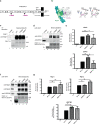Neurexin 1 variants as risk factors for suicide death
- PMID: 34168285
- PMCID: PMC8709873
- DOI: 10.1038/s41380-021-01190-2
Neurexin 1 variants as risk factors for suicide death
Abstract
Suicide is a significant public health concern with complex etiology. Although the genetic component of suicide is well established, the scope of gene networks and biological mechanisms underlying suicide has yet to be defined. Previously, we reported genome-wide evidence that neurexin 1 (NRXN1), a key synapse organizing molecule, is associated with familial suicide risk. Here we present new evidence for two non-synonymous variants (rs78540316; P469S and rs199784139; H885Y) associated with increased familial risk of suicide death. We tested the impact of these variants on binding interactions with known partners and assessed functionality in a hemi-synapse formation assay. Although the formation of hemi-synapses was not altered with the P469S variant relative to wild-type, both variants increased binding to the postsynaptic binding partner, leucine-rich repeat transmembrane neuronal 2 (LRRTM2) in vitro. Our findings indicate that variants in NRXN1 and related synaptic genes warrant further study as risk factors for suicide death.
© 2021. The Author(s).
Conflict of interest statement
NW takes responsibility for the integrity of the data and the accuracy of the data analysis. QSL is an employee at Janssen Research & Development, LLC and owns stock/stock options in the company; no other authors have conflicts of interest relevant to the content of this paper, including no financial interest, relationships, or affiliations.
Figures




References
-
- Suicide Statistics — AFSP [Internet]. [cited 2019 Oct 8]. Available from: https://afsp.org/about-suicide/suicide-statistics/.
-
- Norris D, Clark MS. Evaluation and treatment of the suicidal patient. Am Fam Physician. 2012;85:602–5. - PubMed
-
- McGuffin P, Marusic A, Farmer A. What can psychiatric genetics offer suicidology. Crisis. 2001;22:61–5. - PubMed
-
- Egeland JA, Sussex JN. Suicide and family loading for affective disorders. JAMA. 1985;254:915–8. - PubMed
Publication types
MeSH terms
Substances
Grants and funding
LinkOut - more resources
Full Text Sources
Medical
Research Materials

